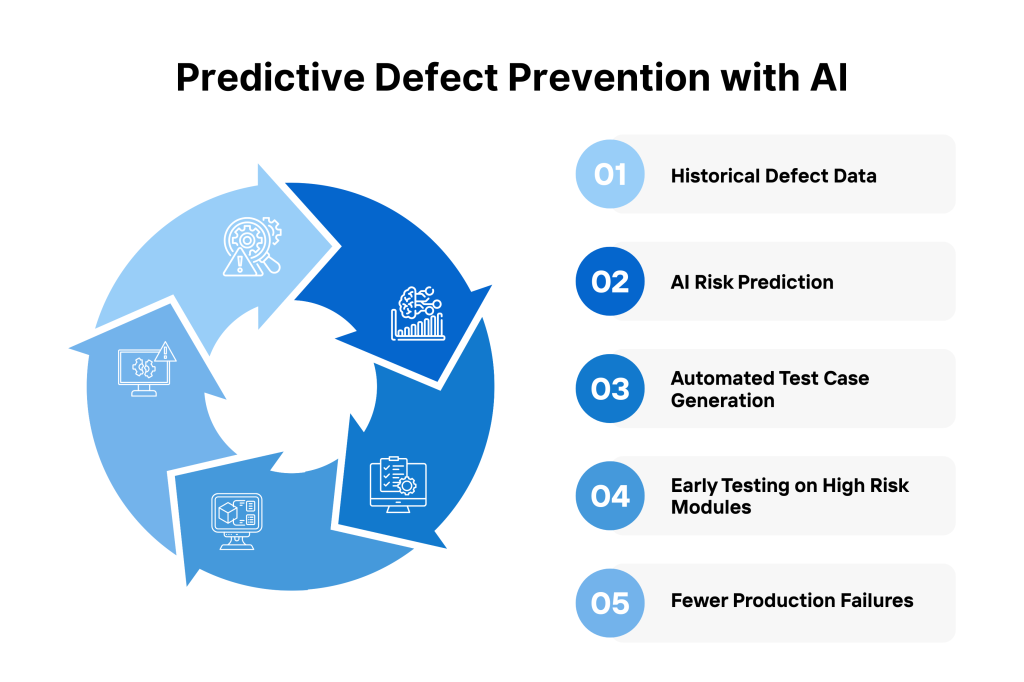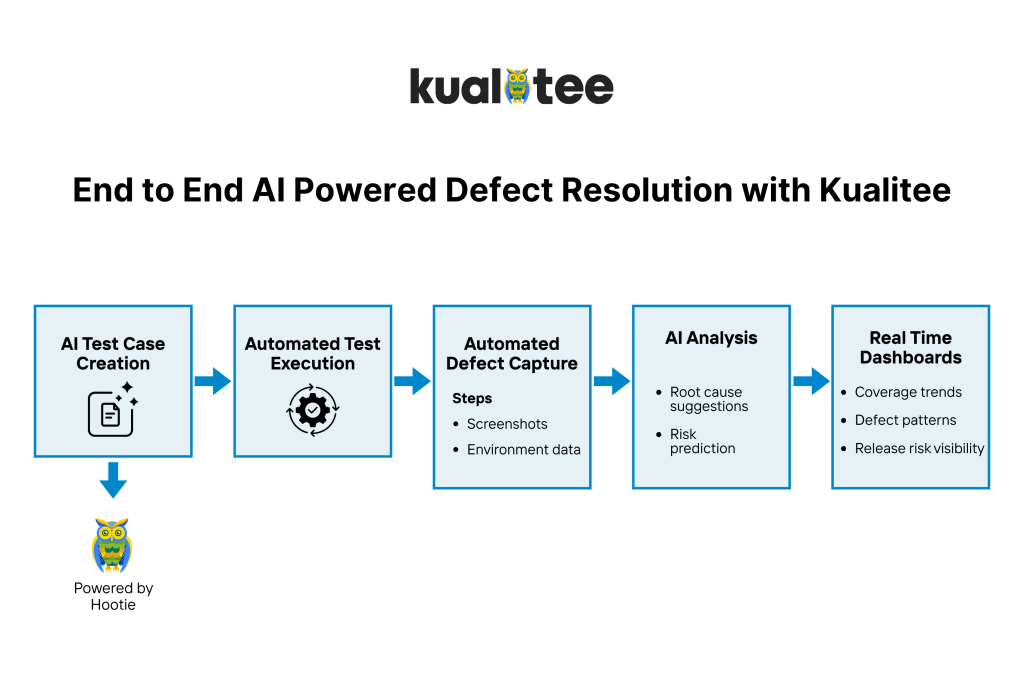A Software testing company has to check software applications thoroughly and report any defects to developers. These defects are then fixed before the program is released to the public.
However, defect resolution is often a daunting task. It takes hours, sometimes days, to get issues fixed without something else breaking. Thankfully, now, the process has been made easier and quicker since AI is here.
Today, we’ll take a look at how artificial intelligence helps in accelerating defect resolution. We’ll also see how Kualitee, an AI-based platform, is helping organizations stay ahead of the curve.
Challenges With Traditional Defect Resolution Process
When there was no AI, defect resolution was largely a manual process. It had a linear path, which was quite predictable. At first, testers or users would report bugs. The developers would investigate these bugs and try to find a solution. Then, oftentimes, the teams would debate about the priority and urgency of each issue.
While the process was tried and tested, it led to bottlenecks. Some of which were:
- Manual triage made it very difficult to determine which issues are critical and which are minor annoyances.
- Root cause analysis took days, especially when the codebases were complex.
- Prioritization was subjective. It relied on experience more than data.

AI takes better care of these things and offers a smarter alternative to processes. More on this below.
How AI Accelerates Defect Resolution
Every stage of the defect resolution process is being quickened by AI. The following is what you can expect by implementing artificial intelligence in this regard.
1. Smart Triage & Prioritization
Every defect doesn’t equally affect the working of a software. This makes it important to prioritize issues. Teams have to determine which ones they should fix first. AI helps here by analyzing historical data, code changes, and affected user segments automatically.
This, in turn, enables teams to:
- Prioritize high-impact defects quickly by considering the AI’s suggestions.
- Allocate resources efficiently.
- Minimize the risk of bugs slipping through the cracks.

2. Automated Root Cause Analysis
As previously mentioned, root cause analysis takes quite some time if it’s done manually. AI changes this by:
- Quickly going through logs and code repositories to trace the origin of defects.
- Using machine learning to localize faults based on test execution data and change history.
- Suggesting possible fixes based on what has proven successful before.
What’s great about root cause automation is that it not only speeds up the process but also reduces the chances of human error. It allows developers to focus on implementing solutions rather than manually searching for problems.

Curious how AI-driven defect resolution actually works in practice?
Sign up for free now and explore Kualitee hands-on.
3. Self-Healing and Anomaly Detection
Advanced AI systems, like the one offered by Kualitee, can monitor test executions in real-time. They can flag anomalies early and even auto-correct flaky tests when needed.
What this ‘self-healing’ does is it minimizes false positives. It ensures that QA teams only focus on issues that are genuine.
On top of that, ‘Broken test scripts,’ where outdated scripts halt progress, is also reduced with AI.
4. Predictive Defect Prevention
AI has the ability to analyze historical bug data along with changes in code. It also knows about the real-time test results since most platforms have it integrated into themselves. This helps it predict where defects are likely to occur in the future, even before a new code is executed.

Furthermore, if any error occurs in production, artificial intelligence models have the ability to generate test cases. Teams don’t have to do it manually. They can focus their efforts on the most vulnerable areas and prevent issues early on to ensure production is smooth.
That said, the key benefits of this are as follows.
- Early detection reduces the time taken for debugging.
- Automated test case generation ensures maximum coverage. Redundancy is also minimal.
- The predictive insights improve software reliability. Failure patterns are highlighted for teams.
5. Actionable Feedback Loops
The dashboards provided by AI-driven platforms give users insights into what’s happening. They show the bottlenecks that have recently occurred, defect density trends, and performance regressions.
This is something that Kualitee offers as well. QA, developers, and managers can see the stuff relevant to them at a glance. Then, once all the information is collected, they can start making decisions.
Want to see how these AI capabilities come together in one platform?
Check Kualitee’s features and explore the full workflow.
AI-Powered Defect Resolution with Kualitee
With Kualitee, all the aforementioned benefits can be practically demonstrated. You get:
- AI Agent Hootie: Kualitee’s very own AI assistant, Hootie, can automate test case creation for QA. With it, you get up to 80% coverage and more free time to focus on complex scenarios.
- Automated Defect Capture & Management: While tests are being executed, Kualitee logs the emerged defects automatically. Steps, screenshots, and environment data are all captured. Furthermore, it categorizes issues as well and logs the test metadata into a unified ticket.
- Real-Time Insights: Actionable analytics on test case coverage are provided by Kualitee. You can also see the execution speed and defect trends. These insights enable QAs to monitor project health and react quickly to new, emerging issues.
- Predictive Guidance: Kualitee compares ongoing test results with past defect trends. It flags modules that are likely to fail. Not just that, escape risk before a release is also estimated by the platform.
- Collaboration and Customization: By choosing Kualitee, you get various features. They include customizable workflows, preconfigured team roles, and seamless tool integrations. This helps in making sure that all relevant people (from testers to developers) are aligned and informed throughout the defect resolution lifecycle.

Planning to adopt AI-driven defect resolution at scale?
Take a look at Kuaitee’s pricing and find a plan that fits your QA goals.
Final Words
Artificial Intelligence has completely changed the way testers go about the defect resolution process. It offers smart triage, automates root cause analysis, provides predictive defect prevention, and much more.
It’s recommended that every individual or organization that provides QA services leverage AI for defect resolution. They can get practical benefits by using Kualitee as it enables automated defect capturing and real-time insights, among other things.
Frequently Asked Questions (FAQs)
Q1) What is AI-based defect management?
AI-based defect management uses machine learning to classify, prioritize and track defects automatically. This reduces manual effort and resolution time for you.
Q2) How does automated defect tracking help QA teams?
It captures defects during test execution with logs and context, improving accuracy and speeding up collaboration between QA and developers.
Q3) What is predictive defect analytics in software testing?
Predictive defect analytics identifies high-risk areas using historical data. It helps teams prevent defects before release.
Q4) How do AI-powered test management tools improve release speed?
They automate test creation, defect analysis and reporting in one place. Platforms like Kualitee help teams release faster without sacrificing quality.













































